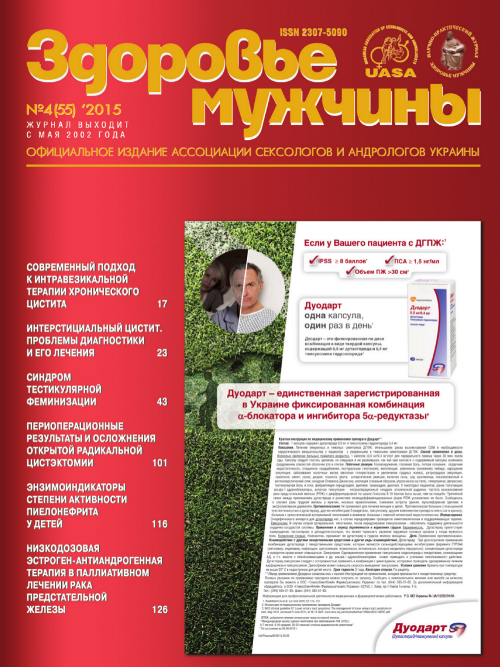Effect of the phytocompound Canephron® N on the efficacy of the extracorporeal shock wave lithotripsy
##plugins.themes.bootstrap3.article.main##
Abstract
Materials and methods. This study was prospective and included randomization. Overall, 642 patients were included with ESWL using «Dornier Compact Delta II». In the first group 320 patients received one day before the ESWL and 90 days thereafter Canephron® N 2 dragees 3 times pro day. In the second group 322 patients did not receive Canephron® N.
Results. In the first group 81.9% of patients were stone free at day 5 after procedure (65.2% in control group), at day 90–93.1% of patients (78.3% in control group). In the second group complications arose in 17.1% of patients, including acute obstructive pyelonephritis (1.2%), steinstrasse in 2.2% and renal colic in 13.7% of patients. Mean hospitalization length was 9.8±0.8 days in the Group 2. In the Canephron® N group complications rate was 1.2% with mean hospitalization duration 6.0±0.5 days. The other putative effects of Canephron® N were increase in the dairy diuresis, stimulation of renal filtration, decrease in the severity of leukocy turia, bacteriuria and proteinuria, compared to the patients in group 2.
Conclusions: Canephron® N could ameliorate the withdrawal of the stone fragments, decrease the complication rate ater ESWL and hospitalization length. It could also reduce the recurrence rate.
##plugins.themes.bootstrap3.article.details##

This work is licensed under a Creative Commons Attribution 4.0 International License.
Authors retain the copyright and grant the journal the first publication of original scientific articles under the Creative Commons Attribution 4.0 International License, which allows others to distribute work with acknowledgment of authorship and first publication in this journal.
References
Аполихин О.И., Сивков А.В., Солнцева Т.В., Комарова В.А. Эпидемиология МКБ в различных регионах РФ по данным официальной статистики. // Саратов. науч. мед. журн. – 2011. – No 7. – С. 120–121.
Brener ZZ, Winchester JE, Salman H, Bergman M. Nephrolithiasis: evaluation and man agement. // South Med J, 2011. – Vol. 104, No 2. – P. 133–139.
Бешлиев Д.А. Опасности, ошибки, осложнения дистанционной литотрипсии. Их лечение и профилактика: Дис. ... д ра мед. наук. – М., 2003.
Аляев Ю.Г., Руденко В.И., Саенко В.С., Дзеранов Н.К., Амосов А.В. Растительный препарат Канефрон Н в лечении больных мочекаменной болезнью // Урология, 2012. – No 6. – С. 22–25.
Синякова Л.А. Современный взглядна профилактику рецидивов инфекций нижних мочевыводящих путей // Consilium Medicum, 2014. – T. 16, No 7. – С. 47–50.
Перепанова Т.С., Хазан П.С. Растительный препарат Канефрон Н в лечении и профилактике инфекций мочевыводящих путей // Врачебное сословие, 2005. – No 4–5. – C. 44–46.
Амосов А.В., Аляев Ю.Г., Саенко В.С. Растительный лекарственный препарат Канефрон Н в послеоперационной метафилактике мочекаменной болезни // Урология, 2010. – No 5. – С. 65–71.
Неймарк А.И., Каблова И.В. Комплексное лечение больных нефролитиазом с использованием Канефрона Н // Урология. – 2008. – No 6. – С. 11–14.
Калинина С.Н., Тиктинский О.Л., Семенов В.А., Тиктинский Н.О., Мелконян А.В. Роль Канефрона Н при лечении хронического пиелонефрита и профилактике его осложнений // Урология. – 2006. – No 1. – С. 22–25.





